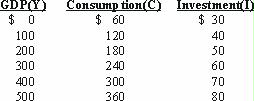| 6. |
| (Advanced analysis) Answer the next question(s) on
the basis of the following data. The letters Y, C, S,
and I are used to represent GDP, consumption, saving, and investment
respectively.

|
| R-4 REF09188 |
The equation representing the consumption schedule for the above economy
is:
|